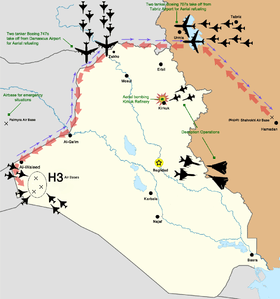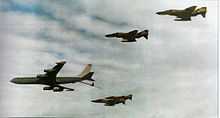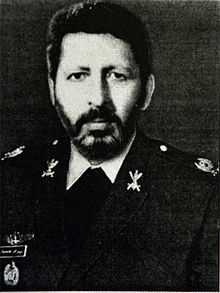H3 airstrike
| H3 airstrike | |
|---|---|
| Part of Iran–Iraq War | |
 Map of the attack | |
| Operational scope | Strategic |
| Location | Al-Waleed Airfield, Iraq 32°44′57″N 39°35′28″E / 32.749177°N 39.591186°E |
| Planned by | Major General Javad Fakoori (the commander of the IRIAF) General Hooshyar |
| Objective | Destruction of the Iraqi military aircraft |
| Date | 4 April 1981 |
| Executed by | |
| Outcome | Iranian Victory |
| Casualties | See Disputed claims |
| ||||||
The H3 airstrike was a surprise air attack by Iran during the Iran–Iraq War in April 1981, against the Iraqi Air Force at H3 Airbase. The Iranians claimed that they destroyed 45 aircraft with no losses of their own. [1]
Operation


The target
Location of H3 airbase was in the west of Iraq in heart of desert near Jordan-Arabia-Syria-Iraq borders and very far from Iran's borders, and was erected to secure the western borders of Iraq, and was used in October War 1973.
H3 or (Al-Waleed) as Iraqi pilots used to refer, and due to the Iran–Iraq War, was used as a support airbase for the Iraqi Air Force and housed not more than a few transportation squadrons,a squadron of MiG-21, as well as retired Hawker Hunters.[2]
In Saddam Hussein's attempts for a successful offensive against Iran on the northern front between 12 and 22 March 1981, Iraq fired two 9K52 Luna-M surface-to-surface Rockets against cities of Dezful and Ahvaz. Within days after this attack, commanders of the 31st and 32nd Tactical Fighter Wing in Shahrokhi Tactical Air Base (TAB 3, near Hamadan) planned a counterattack. According to Iranian intelligence, the Iraqi Air Force removed most of their valuable assets to its Al-Wallid air base on the Baghdad-Amman highway close to Jordanian border, part of H-3 complex.
Planning
For the operation against Al-Wallid, the 31st and 32nd Tactical Fighter Wings (TFW) employed F-4E Phantom crews, four F-14A Tomcats, one Boeing 747 airborne command post and three Boeing 707 tankers. Senor Iranian military officials had devised Iraqi Air Forces activity was lower in northern Iraq, so a plan was made to approach the Iraqi sites from that direction. Aside from Iraqi interceptors, Iranian pilots had to be careful to avoid SAM sites in order to reach their target. Al-Wallid was almost 1500 kilometres from Hamedan, and Phantoms had to fly over Baghdad.
To increase their chances, Iranian commanders decided to fly their aircraft to Urmia Lake first, and then from there they would have a "clean" route passing over the mountains of Northern Iraqi-Turkish border. Since Phantoms could not reach their target without a number of aerial refueling, two Boeing 747 had to be sent to Syria in order to help the operation by meeting the strike group somewhere over western Iraqi border.
The attack
The operation began at 10:30am of the April 4, 1981. A formation of eight F-4E, accompanied by two airborne reserves started from Hamedan AFB (TAB 3) towards Urmia Lake and then after refueling over the friendly airspace they crossed into Iraq. A pair of F-14 Tomcats patrolled the area hours before and after the strike began to counter any interception attempts by the Iraqi Air Force. Two Boeing 747 tankers were deployed to Damascus airport in Syria a day before the mission began. The command to commence the attacked was received during aerial refueling operations Iranian air space. Colonel Izadseta supervised the operation in a command 747 in Syria's air space.
The Phantoms split their formation into two sections. This allowed attacks to come from several directions on the H3 complex. Both runways at Al-Wallid were targeted in order to prevent any Iraqi aircraft from taking off. Cluster bombs of the second group of Phantoms damaged three large hangars. By the second group's attack was completed the Iraqi military forces had not established a coordinated counter-attack. Effective anti-aircraft fire was impaired due to the surprise attack. The Iranian Phantoms able to make multiple attacks on multiple targets with cannon fire.
After the attack the Iranian formation turned back towards their own bases. Iranian military officials stated that all Iranian F-4E aircraft were undamaged during the attack on Al-Wallid.[3] Iraqi interceptors were scrambled an unsuccessful attempt to intercept.
In 2015 the actual flight path has been released, you can see it here: https://commons.wikimedia.org/wiki/
Disputed claims
Iraqi sources claim that a single MiG-21U was damaged by the attack. And they claim that the damaged hangars were empty at the time of the attack, they also pointed the TU-22 and the TU-16 were stationed at Tammuz Airbase due to the ongoing war with Iran, they stayed in Tammuz Airbase until they got retired from the Iraqi Air Force in late 1980's, and then bombed in 1991 during Gulf War,.[4][5]
Iraq denied any losses of any Mirage F1s since all were located in an airbase built specially for them with a request from the French government, the Mirage airbase called Saddam Airbase, and was located approximately 300 kilometers North of Baghdad...[6]
Iran claimed that at least 48 Iraqi Aircraft were damaged or destroyed. Iran officials claimed up to five Iraqi Mirage F1s were destroyed during the attack.
According the Iranian intelligence, prior to the attack there were at least two squadrons equipped with ten Tu-22B and at least six Tu-16 heavy bombers as well as two other units with MiG-23BNs and Su-20s were hidden. This has been disputed by Iraqi officials.
Iraqi air defense command later claimed that Syrian interceptors were helping Iranians during the attack, and their radar followed Phantoms for some 67 minutes.[7]
References
- ↑ Mehrnia, Brigardier General Ahmad (2014). "Attack on Al-walid book by Gen.mehrnia". IRIAF official webpage (www.AJA.ir) Note : since this source is in Farsi , the phrase which is cited is : "طبق گفته خود عراقيها در اين عمليات 48 فروند هواپيماهاي عراقي و بنا به برخي منابع ديگر تا 80 فروند هواپيما در اين عمليات منهدم شد و بخش زيادي از تجهيزات هوايي دشمن در اين عمليات از بين رفت " .
- ↑ Iraqi Fighters: 1953-2003: Camouflage & Markings ISBN 978-0615214146
- ↑ Cooper and Bishop Air Enthusiast March/April 2004, pp. 7–8.
- ↑ The Power and the Strategic Role of the Iraqi Air Force 1931-2003 Lt. General Alwan Alubosi {Chapter Three}
- ↑ The Iraq-Iran War: Memoirs of a Fighter General Nazar Al-Kazraji ISBN 978-9953029047
- ↑ Iraqi Fighters: 1953-2003: Camouflage & Markings ISBN 978-0615214146 Page 95 and on
- ↑ Assault on Al-Wallid, Historical Iranian attack against H-3 base in 1981.